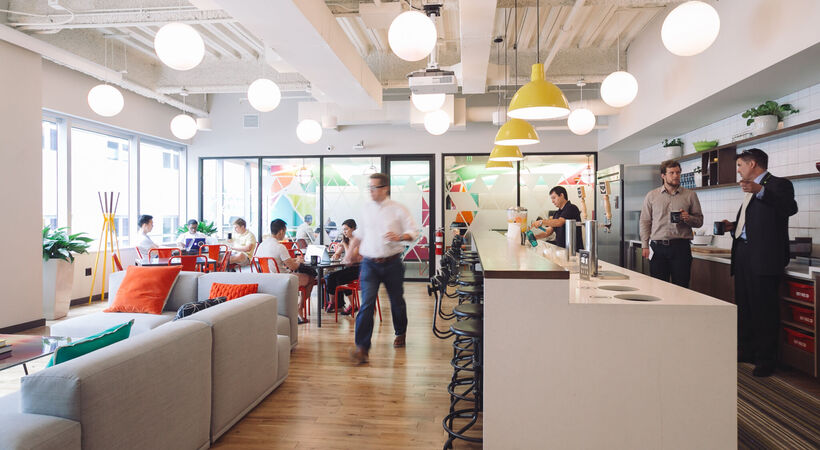Kas Mohammed, VP of digital energy at Schneider Electric says that the return to workplace is about more than preparation – it is about motivation.
For over a year now, we have been working from home with many office buildings sitting dormant. While companies have felt pressure to downsize their real estate, the physical workplace is likely going nowhere.
The most plausible future of work is a flexible hybrid model, where employees can choose whether they work from home or an office on given days. While this system may require less dedicated workspace, it does demand a change in how current building stock is utilised and how future offices are designed and built.
Quite rightly up to this point, real-estate and facility manager conversations have focused on workplace safety. From room design to ventilation, building developers and managers must ensure their building is capable of meeting new requirements and new expectations of their occupants.
While safety will remain key, the next phase of the future of work goes beyond updating the building to make it a viable option. It requires a fundamental shift toward making the workplace as enticing, engaging and interactive as possible to improve attendance and productivity. Post-pandemic, employees will need to be motivated to return and be confident it will be worth the commute.
For both phases, building technology provides the key. From access control and space management, to understanding employees needs and ultimately creating a happier, more productive and connected workforce, building developers and operators must understand the role of technology in the future of work.
Phase 1: Creating a safe environment
Building controls integrated with other smart building technology and applications are key to simplify, improve, and automate safety, as well as risk management. These technologies can play a central role in monitoring the environment to ensure it is as safe and comfortable as possible.
Critically, building environmental sensors can monitor air temperature and humidity, circulation of fresh outside air, as well as water temperature and flow, to understand the risk transmission in buildings. Indoor Air Quality (IAQ) sensors connected to building management are fundamental to ensuring those conditions are maintained throughout the building.
People flow counters, area counters, and occupancy sensors can be used to detect a different type of threat: occupancy patterns that are in violation of site guidelines or policies. Today, building operators need to know the number of people on site at all times and maintain proper spacing between occupants. These technologies can be used to ensure occupants are adhering to social distancing requirements or staying away from areas that haven’t been sanitised after use or are at risk of having been contaminated with a virus or bacteria.
Phase 2: Creating demand for a return to work
If building developers utilise and integrate smart building technology, the public will soon realise going back to work is safe. However, this will not detract from some of the perks working from home brings. No commutes, more family and leisure time, a greater sense of autonomy – these advantages cannot be displaced by simple meeting safety concerns. To motivate people back to the office, real estate professionals need to fundamentally rethink the office environment and experience.
This starts with individual control. At home, we are used to technology making our lives easier and more comfortable. We must begin to recognise that smart systems – connecting Internet of Things enabled devices – are fundamental to improving the working experience, both for workers and employers.
In the future, building apps will create a more productive environment. Much like in our domestic lives, workplace virtual assistant applications could be used to check if meeting rooms are free, order a drink from the ground floor cafeteria, change temperature, call a lift or schedule to work from home. Such apps would improve control and act as the motivating factor to getting people back to the office. Having true, live insight into air quality, office capacity and being able to control your personal environment cannot help but provide reassurance and motivation.
We must go further than mitigating risk, if we want to create a truly effective and productive workforce. Building developers and managers must look to make the ultimate environment for employees – whereas table tennis tables and Friday drinks once passed for a good workplace, modern employees demand flexibility and control in every aspect of their lives.
The future of work is built on connectivity
Today, many of our buildings suffer from one key issue – the building data produced is siloed to the extent that actionable insights are almost impossible to gleam. When room occupancy, lighting, heating and ventilation data is captured, it lives in separate data environments with no connecting thread between them. For our workplaces to achieve their full potential, all systems need to be connected across the building infrastructure. By doing so employees can benefit from a comfortable, controllable and safe environment, while buildings managers can manage power quality and consumption, understand building performance, and save energy and costs.
For such change to come into effect, there must be buy in across the business spectrum, from company heads and real-estate managers, to facility and office managers. A central building management system functions as the ‘brain’ of the facility – connecting all devices and assets to create a single source of truth to be drawn from. This critical smart building technology can no longer be an afterthought and must be included as a fundamental element in every building.





